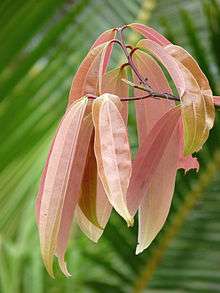Malabathrum
- This article is about the ointment historically known as malabathrum, and the leaves from which it was prepared. For one of the plants which was a source of those leaves see Cinnamomum tamala

Malabathrum, malabathron, or malobathrum, is the name used in classical and medieval texts for certain cinnamon-like aromatic plant leaves and an ointment prepared from those leaves. Cinnamomum tamala (sometimes given as Cinnamomum tejpata), grown most commonly in the eastern Himalayas, are thought to be notable sources of these leaves,[1] although other species of Cinnamomum and even plants in other genera [2] may also have been used. In ancient Greece and Rome, the leaves were used to prepare a fragrant oil, called Oleum Malabathri, and were therefore valuable.
Malabathrum is mentioned in the first century Greek text Periplus Maris Erytraei and sourced to a people called Sêsatai, identified with Kirradai (Kirata) of Ptolemy.[3] Though Malabathrum was a product of Northeast India, it was rarely traded by the western traders at the mouth of the Ganges, which is much closer to the source, but at southwestern Indian ports of Muziris/Nelkynda[4] It is mentioned in the Periplus that some people collected the green leaves after the Sêsatai in the northeast, prepared them, and carried them to the ports of trade.[5] In the language of Kerala, Malayalam, the plant is called 'Vazhana'. It is also known as 'Edana' in Malayalam. The name Malabathrum is also used in mediaeval texts to describe the dried leaves of a number of trees of the genus Cinnamomum, which were thought to have medicinal properties.
The Greeks used kásia (cassia) or malabathron to flavour wine, together with absinth wormwood (Artemisia absinthium). Malabathrum leaves (folia) were used in cooking and for distilling an oil used in a caraway-sauce for oysters by the Roman gourmet Gaius Gavius Apicius.[6] Malabathrum is among the spices that, according to Apicius, any good kitchen should contain. Malobathrum from Egypt (Dioscorides I, 63) was based on cattle-fat and contained cinnamon as well; one pound cost 300 denars.
Etymology
The word "malabathrum" is the Hellenization of the Sanskrit word tamālapattram (तमालपत्त्रम्), literally meaning "dark-tree leaves," the ta being mistaken for the Greek definite article.[1]
Notes
- 1 2 (Casson 1989, p. 241)
- ↑ "Latin Lexicon". Retrieved 2012-11-07.
- ↑ (Casson 1989, pp. 241–242)
- ↑ (Casson 1989, p. 16)
- ↑ "Thus three grades of malabathron are produced, and then they are transported into India by the people who make them." Periplus Chap 65. (Casson 1989, pp. 91-93)
- ↑ De re coquinaria, I, 29, 30; IX, 7
References
- Casson, Lionel (1989). The Periplus Maris Erythraei: Text With Introduction, Translation, and Commentary. Princeton University Press. ISBN 0-691-04060-5.